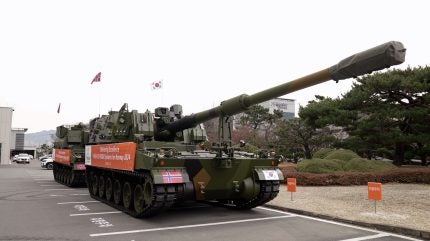
The two-month-long delivery journey of four K9 155mm self-propelled howitzers (SPH) and eight K10 ammunition resupply vehicles to Norway is underway, according to manufacturer Hanwha Aerospace, in an expansion of an earlier contract to supply the tracked SPH.
Signed in 2017, the original deal called for the provision of 24 K9s and six K10s to the Norwegian Armed Forces, with the South Korea-designed SPH gaining significant penetration into the international market as the one of very few new-build tracked artillery systems.

Discover B2B Marketing That Performs
Combine business intelligence and editorial excellence to reach engaged professionals across 36 leading media platforms.
Since 2001, the K9 has been ordered by nine countries – Turkey, India, Poland, Norway, Finland, Estonia, Australia, Egypt, and Romania – with about 1,800 K9 vehicles being in service around the globe.
The 47-ton, 155mm/52-calibre K9 155mm SPH, dubbed ‘Thunder’ by Hanwha Aerospace, can deliver rounds to a range of over 40km utilising a ‘shoot-and-scoot’ fire mission, where a mobile artillery piece quickly fires a group of munitions before departing to avoid counter-battery fire.

Hanwha Aerospace states that the K10 is the world’s first automatic ammunition resupply vehicle based on the chassis of K9 howitzer, sharing most of the components and characteristics for logistics support. The vehicle can support the K9 by carrying and resupplying 104 shells of 155mm artillery ammunition and 504 units of charges under contested conditions.
Analysis by GlobalData into Norway’s military equipment inventory shows that the Norwegian Armed Forces also maintains around 14 of the older M109A3GN 155mm SPH, acquired from BAE Systems between 1969-1971.

US Tariffs are shifting - will you react or anticipate?
Don’t let policy changes catch you off guard. Stay proactive with real-time data and expert analysis.
By GlobalDataNorway’s defence budget was anticipated to rise from $7.6bn in 2023 to $9.2bn in 2028, an increase of $1.6bn over 2023–28, as it seeks to modernise its military in light of Russia’s ongoing war in Ukraine.
Tracks vs Wheels: artillery design shift?
The acquisition of the K9 SPH by Norway and other European countries point to a potential capability gap in the continent’s defence manufacturing capability, with wheeled artillery platforms such as the French CAESAR, Sweden’s Archer, and the German RCH 155 currently in-vogue.
Germany’s KNDS is still manufacturing the Panzerhaubitze 2000 tracked 155mm SPH, Western Europe’s sole remaining tracked artillery in production, mainly in support of Ukrainian requirements.
Wheeled platforms have an advantage over tracked alternatives in terms of peace time mobility, transit distances, and ease of maintenance. In combat situations a tracked platform was traditionally preferred for the ability to armour the platform more heavily and provide all-terrain mobility.
However, experience in Ukraine has shown that wheeled artillery could be preferred in contemporary conflict due to its ease of use and cost-effectiveness.




